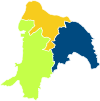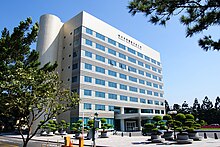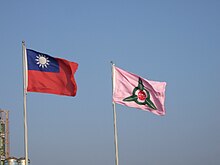Hsinchu
|
Hsinchu City 新竹市 |
|||
 Railway station in Hsinchu, who during the Japanese rule was established |
|||
|
|||
| State : |
|
||
| County : | District-free city | ||
| Coordinates : | 24 ° 49 ′ N , 120 ° 59 ′ E | ||
| Area : | 104.1526 km² | ||
| Residents : | 445,990 (Jan 2019) | ||
| Population density : | 4,282 inhabitants per km² | ||
| Time zone : | UTC + 8 (Chungyuan time) | ||
| Telephone code : | (+886) (0) 3 | ||
| Postal code : | 300 | ||
| ISO 3166-2 : | TW-HSZ | ||
| Structure : | 3 districts ( 區 , Qū ) | ||
| Mayor : | Lin Chih-chien ( 林智堅 ) ( DPP ) | ||
| Website : | |||
| City bird: | magpie | ||
| City flower: | azalea | ||
| City tree: | Black pine | ||

|
|||
Hsinchu ( Chinese 新竹市 , Pinyin Xīnzhú Shì , Tongyong Pinyin Sinjhú Shìh , W.-G. Hsin-chu Shih , Zhuyin ㄒ ㄧ ㄣ ㄓ ㄨ ˊ ㄕ ˋ - "new or fresh bamboo") is a city in the northwest of the republic China on Taiwan with 431,029 inhabitants and an area of 104.1526 km². (As of September 2014) It is often called the “windy city” ( Chinese 風 城 / 风 城 , Pinyin fēngchéng - “city of the wind”) because of its strong cross-strait wind .
Hsinchu is best known for its high concentration of semiconductor manufacturers . A duty-free zone - the Hsinchu Technology Park (Hsinchu Science-based Industrial Park) - has been set up, in which more than 20 semiconductor plants have been built. Among other things, the corporate headquarters of the LCD flat screen manufacturer AU Optronics and the two world's largest semiconductor foundries : TSMC and UMC , but also other semiconductor companies such as Elan , Winbond and Powerchip are located in the industrial park . The companies Sinonar and NexPower manufacture solar cells and solar modules here.
Tsing Hua State University and Chiao Tung State University are also located in Hsinchu . The former was founded in Beijing in 1911 as a preparatory school for further studies in the USA and expanded into a full university in 1925 (Tsing Hua University). During the Chinese Civil War and World War II , Tsing Hua University merged with Beijing State University and Nankai State University. In the course of the civil war there was a split and part of the faculty moved to Hsinchu in 1955. The Tsing Hua Institute for Nuclear Science was founded there. From this, the State Tsing Hua University emerged in 1956.
Both universities have been in stiff competition since they were founded. The rivalry is particularly evident in the annual Mei Chu tournament / Mei Zhu tournament ( 梅 竹 賽 / 梅 竹 赛 , Méi-Zhú-Sài ), a series of sports and game competitions in March. The ratio is often compared to that of Athens (NTHU) and Sparta (NCTU), or Cambridge and Oxford .
history
The city of Hsinchu was once the home of the Taokas, one of Taiwan's indigenous tribes. Her old name was "Zhúqiàn", which means something like "bamboo trench". The Taokas originally lived in the wetlands around Xiangshan and did not open up the northern areas of Taiwan until later.
In 1711 Wang Shijie ( 王世傑 / 王世杰 , Wáng Shìjié ), the first settler from southern Fujian , immigrated to Hsinchu. He lived at 36 Dongqian Street ( 東 前街 36 傑 , Dōngqiánjiē 36 Jié ), the oldest street in Hsinchu, which is also called the "dark street". Many of today's fields were created at this time.
In 1723, Danshui Sub- Prefecture was established in Hsinchu. To improve the security of the city, eleven years later bamboo was grown for a city fortification and four tower gates were erected. Now the name Hsinchu ( 新竹 , Xīnzhú ), "New Bamboo", was appropriate .
In 1826, 47 members of the local nobility, u. a. the first Jinshi ( Chinese進士 / 进士Pinyin jìnshì) of Taiwan's Zheng Yongxi ( 鄭 用 錫 / 郑 用 锡 , Zhèng Yòngxí ) to build a stone wall, which should be financed by the residents. The request was granted and a new city wall with a moat and four tower gates were built: the east gate Yingxi ( 迎曦 , Yíngxī ), the west gate Yishuang ( 挹 爽 , Yìshuǎng ), the south gate Gexun ( 歌 薰 ) and the north gate Gongchen ( 拱辰 ). Furthermore, the streets leading to the gates were expanded to 3.8 m. Nowadays only the east gate and parts of the moat have survived.
In 1875, the Qing Imperial Court dissolved Danshui Sub-Prefecture and divided northern Taiwan into three districts, Danshui , Hsinchu and Yilan. Hsinchu and Yilan counties still exist today.
In 1895, China had to cede the island of Taiwan to Japan. Under the new rule of the Japanese , Hsinchu was organized as a sub-prefecture. During the following 50 years of Japanese colonial administration, the image of the city changed fundamentally. A railway line was built, the streets widened and many old buildings and the city wall torn down. From 1920, Hsinchu was the capital of the newly established Shinchiku Prefecture , which included the area of the city of Hsinchu and that of today's districts of Hsinchu , Miaoli and the city of Taoyuan . After the island of Taiwan came to the Republic of China after the end of World War II , an administrative reform took place and Hsinchu became a city on February 28, 1946. The urban area was then divided into seven districts: North, East, West, South, Zhudong , Baoshan and Xiangshan. On October 25, 1951, the city was expanded to include the area of today's Guanxi , Xinpu , Hukou , Hongmao , Zhubei , Huangshan , Qionglin , Beipu and Emei counties, so that it encompassed most of what is now Hsinchu County. In the following year, however, it lost its district freedom as part of a further administrative reform, became part of the Hsinchu district and limited to the merged former districts of North, East, West and South.
The government of the Republic of China, which initially ruled all of China, concentrated its work on industrial development and the development of mineral and energy resources. In 1980, the Hsinchu Science Park was established in Hsinchu, bringing high-tech and high-quality technical products from its own production to the city. The Research Institute for Industrial Technology (ITRI), which was founded in 1973 in Hsinchu and was the nucleus for Taiwan's IT industry , became of great importance .
On July 1, 1982, the county town of Hsinchu was enlarged by the community of Xiangshan, then received the status of an independent city in the province of Taiwan and thus left the county. On November 1, 1990, the administrative division into three districts - North, East and Xiangshan.
Administrative structure
Hsinchu is divided into three districts (區Qu ), which in turn are divided into a total of 120 districts ( 里 , Lì ):
| district | Residents | surface | ||
|---|---|---|---|---|

|
As of Jan. 2019 | km² | Ew./km² | |
| Northern District ( 北區 , Běi qū ) | 151.714 | 15.7267 | 9,633 | |
| Eastern District ( 東區 , Dōng qū ) | 215,897 | 33.5768 | 6,411 | |
| Xiangshan ( 香山 區 , Xiāngshān qū ) | 78,379 | 54.8491 | 1,428 |
economy
- Tecom (manufacturer of telecommunications equipment)
- Taiwan Semiconductor Manufacturing Company Limited (the world's largest independent semiconductor- specialized foundry (chip factory))
climate
| Hsinchu | ||||||||||||||||||||||||||||||||||||||||||||||||
|---|---|---|---|---|---|---|---|---|---|---|---|---|---|---|---|---|---|---|---|---|---|---|---|---|---|---|---|---|---|---|---|---|---|---|---|---|---|---|---|---|---|---|---|---|---|---|---|---|
| Climate diagram | ||||||||||||||||||||||||||||||||||||||||||||||||
| ||||||||||||||||||||||||||||||||||||||||||||||||
|
Climate data from the years 1981–2010
Source: Taiwan Central Weather Bureau
|
||||||||||||||||||||||||||||||||||||||||||||||||||||||||||||||||||||||||||||||||||||||||||||||||||||||||||||||||||||||||||||||||||||||||||||||||||||||
Higher education and research institutions
- Tsing Hua National University (NTHU)
- Chiao Tung National University (NCTU)
- Chung Hua University
- Hsuan Chuang University
- Yuanpei University of Science and Technology
- Research Institute for Industrial Technology (ITRI)
- NSRRC National Synchrotron Center
- NCHC National Supercomputing Center
- NCTS National Center for Theoretical Sciences
Sister cities
The city of Hsinchu has the following ten sister cities or regions (as of the date of the agreement):
-
 Richland , Washington , USA (June 6, 1988)
Richland , Washington , USA (June 6, 1988) -
 Beaverton , Oregon , USA (June 7, 1988)
Beaverton , Oregon , USA (June 7, 1988) -
 Cary , North Carolina , USA (March 31, 1993)
Cary , North Carolina , USA (March 31, 1993) -
 Fairfield City , New South Wales , Australia (September 8, 1994)
Fairfield City , New South Wales , Australia (September 8, 1994) -
 Chiayi , Republic of China to Taiwan (October 9, 2002)
Chiayi , Republic of China to Taiwan (October 9, 2002) -
 Okayama , Japan (April 21, 2003)
Okayama , Japan (April 21, 2003) -
 Plano , Texas , USA (September 22, 2003)
Plano , Texas , USA (September 22, 2003) -
 Puerto Princesa , Palawan , Philippines (February 10, 2006)
Puerto Princesa , Palawan , Philippines (February 10, 2006) -
 Cupertino , California , USA (March 9, 2007)
Cupertino , California , USA (March 9, 2007) -
 Airai , Palau (April 20, 2011)
Airai , Palau (April 20, 2011)
sons and daughters of the town
- Yuan T. Lee (* 1936), US-Taiwanese chemist and 1986 Nobel Prize winner
- Chi Cheng (* 1944), Taiwanese athlete, Olympian and politician
- David Wu (* 1955), US-Taiwanese politician, Democratic member of the US House of Representatives for Oregon
- Cho-Liang Lin (* 1960), American-Taiwanese violinist
literature
- Junq-Tzer Lin: The Garden City: Hsinchu City Edition 2007 . Hsinchu 2006, 167 pages
Web links
- Official website of the Hsinchu City Government
- National Tsing Hua University (English)
- National Chiao Tung University ( Memento from January 15, 2012 in the Internet Archive )
- Hsinchu City News on Taiwan Headlines (English)
Individual evidence
- ↑ a b History of Hsinchu. Hsinchu City website, accessed August 18, 2018 .
- ^ History of the Council. Hsinchu County Council, accessed August 18, 2018 .
- ↑ itri.org.tw
- ↑ nsrrc.org.tw
- ↑ nchc.org.tw
- ↑ cts.nthu.edu.tw
- ^ Sister cities. Hsinchu website, accessed September 1, 2019 .






